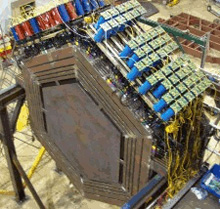Intensity Frontier
MINERvA
MINERvA is a neutrino-scattering experiment that uses the NuMI beamline at Fermilab to search for low-energy neutrino interactions. It is designed to study neutrino-nucleus interactions with unprecedented detail.
The number of neutrinos that detectors can observe increases with both neutrino beam intensity and detector size. The high intensity of the NuMI beamline, the most intense high-energy neutrino beam in the world, allows MINERvA to use a relatively small detector with many sensitive channels per unit volume to zoom in on the details of the neutrino interaction. This attention to detail will allow MINERvA to study the properties of the nuclei struck by the neutrinos and also to examine neutrino reactions.
To identify particles emerging from neutrino interactions, the MINERvA detector uses plastic scintillators that emit light when charged particles go through them. If placed end-to-end, the scintillator bars in the MINERvA detector would stretch 70 miles, about the distance from Fermilab's site in Batavia, Ill., to downtown Chicago and back. Fermilab, in collaboration with Northern Illinois University and with support from the state of Illinois, reduced the cost of procuring those scintillators by developing a state-of-the-art scintillating plastic extrusion facility on site. Engineers at the facility now build high-quality, low-cost detectors for particle physics experiments all around the world.
Researchers have installed the detector in front of the near detector for the MINOS, or Main Injector Neutrino Oscillation Search, experiment at Fermilab.
MINERvA is a collaboration of nuclear and particle physicists from 24 institutions in the United States, Europe and South America. Technicians finished the first detector test module in early 2007 and completed the detector construction in January 2010. Detector installation was completed in March 2010.



